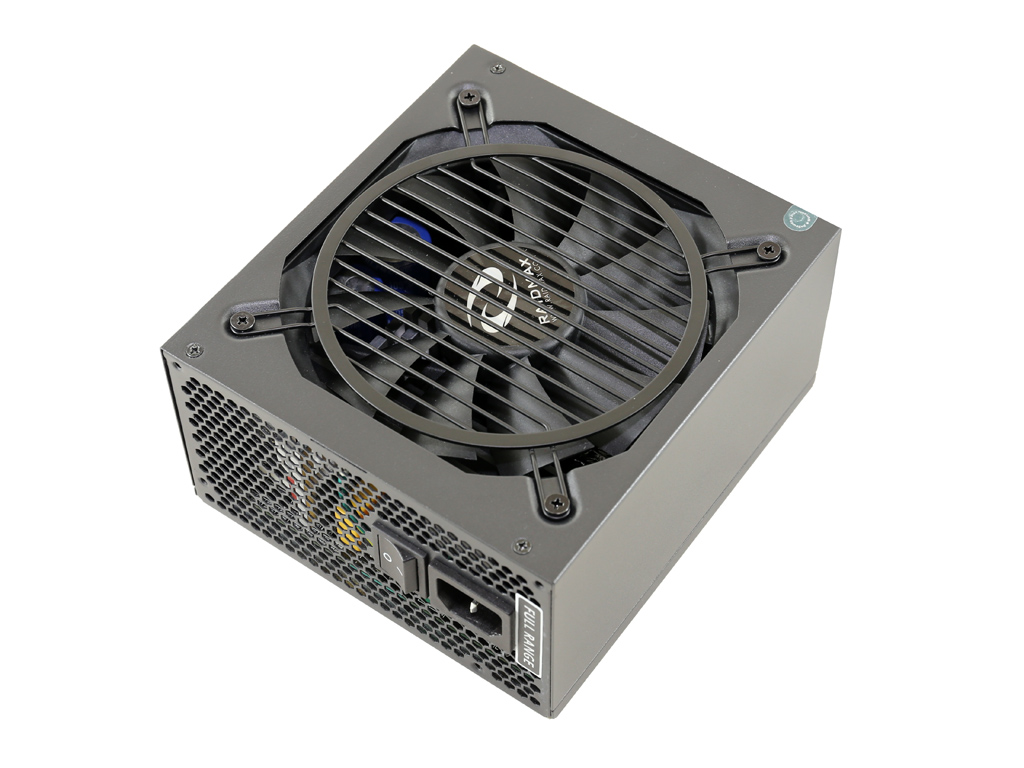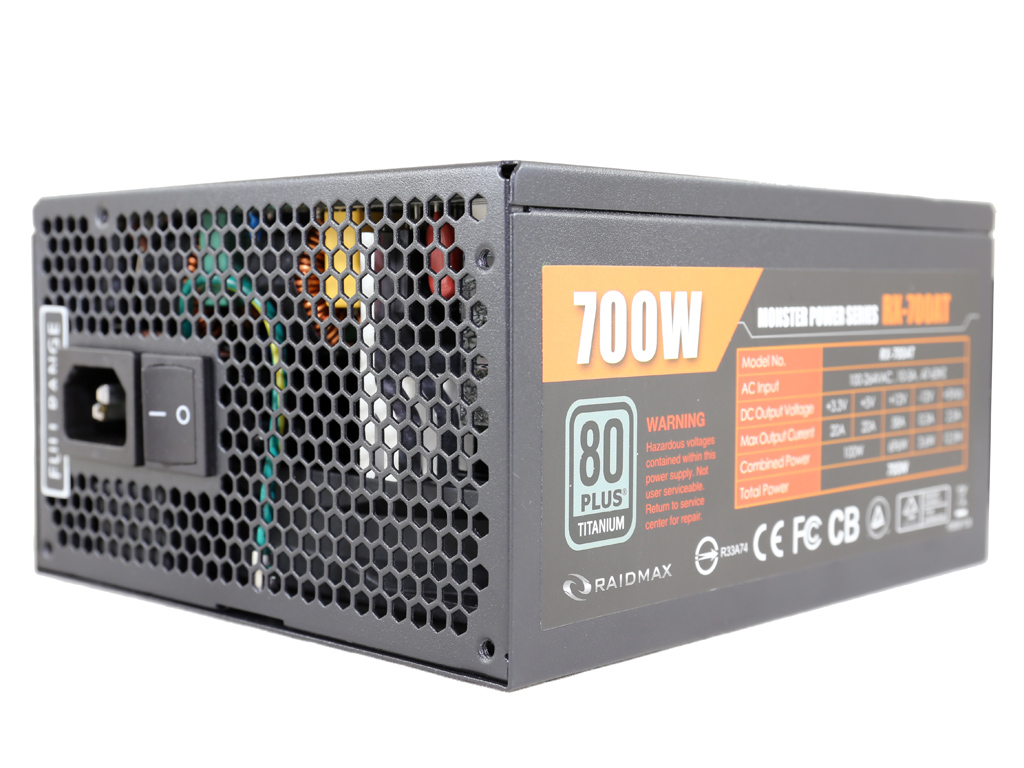Early Verdict
Raidmax's RX-700AT is a highly efficient PSU, however it suffers from a low hold-up time and its MSRP puts it in a high competition zone. With a lower price it would be a much more appealing product. Finally, the warranty has been extended to five years (from two) and this shows that Raidmax is willing to follow the competition's example in this area.
Pros
- +
Full power at 47 °C • Efficient • Load regulation • Ripple suppression at +12V • Quality caps • Silent (at normal conditions) • 5VSB performance
Cons
- -
Expensive • Hold-up time • Inrush current • Single EPS connectors • Warranty (Update 5/18/2016: The provided warranty has been extended to five years so this isn't a con any more)
Why you can trust Tom's Hardware
Introduction
Raidmax chose a strange name for its new PSU. When you hear the word "monster," you either expect a bad external design or limitless capacity. But neither assumption holds true. Nevertheless, Radmax's Monster RX-700AT utilizes Andyson's new Titanium-rated platform that delivers excellent performance and ultra-high efficiency. In fact, as far as we know, Raidmax is the first company using this platform, so we're curious to see how it fares compared to the Andyson N700. The truth is that Andyson isn't one of the more active PSU manufacturers, and with its new 700W Titanium and 1200W Platinum designs, the company has the chance to gain popularity among partners looking for differentiated products.
For the most part, Raidmax focuses on the mainstream segment; its presence in the high-end space is limited. Most of its PSUs are made by Andyson. The only exception is the Vampire Power family (there's another strange name) manufactured by HEC/Compucase. The RX-700AT we're testing today shares the same platform with Andyson's Titanium N700. It achieves Titanium efficiency without a bridge-less design, which is mostly used in higher efficiency Titanium units. In order to restrict energy losses, this PSU employs a semi-modular design with more fixed cables. Removable cables incur increased impedance compared to native ones, leading to voltage drops. In short, energy is lost on modular sockets. This affects efficiency, and when you're gunning for a Titanium rating without a cutting-edge design, you have to minimize loss wherever you can.

Significant amounts of energy are lost on a PSU's bridge rectifiers, since they consist of diodes subject to voltage drops. Thus, all high-capacity Titanium-rated PSU designs use FETs instead of bridge rectifiers. In a FET, the lower the Rds (on) parameter (representing the resistance between source and drain), the lower the energy losses, especially under high currents. However, bridge-less designs require a more sophisticated APFC converter, more FETS and more boost diodes. All of that increases costs compared to conventional bridge rectifiers. Andyson's decision to go with a less exotic platform makes more sense in this context.
Specifications

Besides Titanium efficiency and semi-modular cabling, the RX-700AT's other notable characteristics include a double ball-bearing fan and compatibility with Intel's C6 and C7 states. Unfortunately, the maximum operating temperature at which Raidmax says the PSU can deliver its full power continuously is 40 °C, whereas the ATX spec recommends at least 50 °C. In addition, over-temperature protection is missing from the feature set. That shouldn't be the case on a PSU with a 40 °C rating. Lastly, Andyson doesn't arm this unit with the semi-passive mode we'd expect to see given its Titanium-class efficiency.
The RX-700AT's dimensions are a little larger than normal, and we don't care at all for the short two-year warranty. Selling for almost $150, that sort of coverage won't get the RX-700AT anywhere near its competition. We can't help but wonder why Raidmax doesn't guarantee the unit for at least five years since that's what Andyson gives you with its similar N700 units. We'll look more closely at this power supply's build quality for hints as to why the warranty is so short.
Power Specifications
| Rail | 3.3V | 5V | 12V | 5VSB | -12V | |
|---|---|---|---|---|---|---|
| Max. Power | Amps | 20 | 20 | 58 | 2.5 | 0.3 |
| Watts | 100 | 696 | 12.5 | 3.6 | ||
| Total Max. Power (W) | 700 |
The minor rails only offer 100W maximum combined power, which should still cover any modern system. On the other hand, one +12V rail delivers up to 58A. That'll support powerful gaming machines. Finally, the 5VSB rail is fairly typical, though we'd like to see it rated for at least 3A since this is still a high-end PSU.
Cables And Connectors
| Description | Cable Count | Connector Count (Total) |
|---|---|---|
| Native | ||
| ATX connector 20+4 pin (520mm) | 1 | 1 |
| 4+4 pin EPS12V/ATX12V (630mm) | 1 | 1 |
| 6+2 pin PCIe (540mm+150mm) | 1 | 2 |
| Modular | ||
| 6+2 pin PCIe (500mm+150mm) | 1 | 2 |
| SATA (500mm+150mm+150mm+150mm) | 2 | 8 |
| Four-pin Molex (500mm+150mm+150mm+150mm) | 1 | 4 |
| FDD adapter (+150mm) | 1 | 1 |
There are too many native cables for our tastes. We know this helps Raidmax hit its Titanium efficiency rating, but we'd rather see Andyson's engineers fine-tune the platform and cut some of the fixed cables. Another major disadvantage is the single EPS connector. This is a high-end PSU and it should be compatible with high-end motherboards that need more than one EPS connection (or at least one EPS connector and an ATX12V one).
The rest of the connectors are ample to deliver this PSU's power effortlessly. There is also an FDD adapter that gives you a four-pin Molex connector in parallel with the Berg connector. The RX-700AT's cable length is adequate, and the same goes for the distance between connectors.
The 24-pin ATX, the EPS and the modular PCIe connectors all use thicker 16-gauge wires for lower voltage drops. The native PCIe connectors and everything else employs normal 18-gauge wires.
Power Distribution
Since this PSU features a single +12V rail, we do not have anything to say about its power distribution.
MORE: Best Power Supplies
MORE: Power Supplies 101
MORE: How We Test Power Supplies
MORE: All Power Supply Content

Aris Mpitziopoulos is a contributing editor at Tom's Hardware, covering PSUs.
-
vladm007 You can see the level of faith Raidmax has on the quality by having a 2 years warranty.Reply -
g-unit1111 Reply17870964 said:You can see the level of faith Raidmax has on the quality by having a 2 years warranty.
Yeah that's kind of a deal breaker. :lol: -
turkey3_scratch Another unit cheating on the PWR_OK tests. I'm sick of this crap. Also, those caps on the modular board don't look like Chemi-Con polymers, they look like electrolytics (not that it matters, I'm just questioning if you made a wording error). I also don't like the lack of a thermistor at all. That's some really high inrush current. They could have dished out some cash for one and a relay. I also think the warranty needs increased, but realistically it should last a lot longer than 2 years.Reply -
powernod Reply17871369 said:Another unit cheating on the PWR_OK tests. I'm sick of this crap. Also, those caps on the modular board don't look like Chemi-Con polymers, they look like electrolytics (not that it matters, I'm just questioning if you made a wording error). I also don't like the lack of a thermistor at all. That's some really high inrush current. They could have dished out some cash for one and a relay. I also think the warranty needs increased, but realistically it should last a lot longer than 2 years.
Exactly my thoughts! ;)
Failure at Power_OK signal & huge amount of inrush current = Deal-breaker for me :pfff: -
Aris_Mp if they provide a 5-year warranty and work on the price it has potential. The inrush current is an easy fix with a relay-bypass relay, however the lower than the required hold-up time isn't so easy addressable. A larger bulk cap will need more Amps to charge and more Amps lead to increase power losses, so efficiency will take a hit.Reply -
basroil Very close to be very good, and then it fails at the holdup time... looks like there's still only two real PSU manufacturers (seasonic and superflower)Reply -
Sakkura Why would anyone wonder why Raidmax only has a 2-year warranty? With the junk they've released in the past, it's a miracle they provide any warranty at all.Reply -
g-unit1111 Reply17872208 said:if they provide a 5-year warranty and work on the price it has potential. The inrush current is an easy fix with a relay-bypass relay, however the lower than the required hold-up time isn't so easy addressable. A larger bulk cap will need more Amps to charge and more Amps lead to increase power losses, so efficiency will take a hit.
I think any warranty above 5 years is kind of redundant. In 7 or 10 years you won't have that PSU anyways since you'll be replacing it with something new to keep up with new tech. 5 years I would say is about the length of time a warranty should be. -
turkey3_scratch Reply17872463 said:Very close to be very good, and then it fails at the holdup time... looks like there's still only two real PSU manufacturers (seasonic and superflower)
Superflower cheats on holdup time on various units. Look at the Leadex Gold 550. The 650 G2 also is a problem most likely, and the 750 G2. -
firefoxx04 I've used their cheaper units 3 times. One failed, however, it's environment was a worst case scenario. Very hot Michigan summer with no ac, dusty room, and almost always running the system with 100% cpu and gpu load.Reply